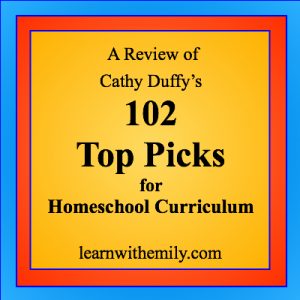This post may contain affiliate links. Affiliate links use cookies to track clicks and qualifying purchases for earnings. Please read my Disclosure Policy, Terms of Service, and Privacy policy for specific details.
As parents enter the homeschooling world, they may wonder where to begin. Although they may not know the requirements for their local area (CLICK HERE to read about how to find out this information), they know that they need to select and buy curriculum. There are a lot of curriculum choices available and it can be difficult to filter through what you like and what would be a good fit for any particular child. Then, if something ends up not being a good fit, the search for something else that would work better begins. The book, “Cathy Duffy’s 102 Top Picks for Homeschool Curriculum” can help guide parents through the process of selecting curriculum that is a good fit for any particular family and child.

 Overview of Cathy Duffy’s Top Picks for Homeschool Curriculum
Overview of Cathy Duffy’s Top Picks for Homeschool Curriculum
Cathy Duffy’s 102 Top Picks for Homeschool Curriculum is not just a book reviewing homeschool curriculum. The book begins by directing the reader to explore personal ideals and values about what you feel is important for your child to learn. Next, the author summarizes different approaches to education (e.g., traditional, classical, Charlotte Mason, etc.) and helps the reader determine which of these best fits their own preferences. The author continues by guiding the reader in formulating their own philosophy of education. Next, different learning styles are covered and discussed. The following chapter helps the parent understand what content should be taught. Now that the basics are covered, the author presents her top 102 curriculum picks. A table helps the reader narrow down the curriculum choices by educational approach, learning style, prep time, religious content (i.e., secular, Protestant, or Catholic) and ease of use for each curricular option.
Benefits
Even as an experienced educator, I found this book helpful. I had never really sat down and thought about what I, personally, felt was important for my children to learn. Faith, values, life skills, and adaptive skills that may not come up in general public education may be very important priorities in a home education. It was also nice to be reminded of my own personal philosophies of education.
Approaches to Education
The chapter about educational approaches explains the popular options. It is helpful to understand the educational approaches and which are a best match for one’s own philosophies of education. For example, I lean towards both Classical and Charlotte Mason approaches in my home school. Curriculum that aligns more with these educational approaches is more likely to work for my family. Cathy Duffy, the author, also includes references to other homeschooling resources based on your approach. For example, those who are interested in a Classical approach to education are directed to read The Well-Trained Mind homeschool book and Ambleside is listed are a resource for those aligning with Charlotte Mason philosophies of education.
Individualized Education Goals
I feel Chapter 5: Who should learn what, and when? would be especially helpful for parents. This chapter directs readers on selecting goals to measure student progress each year. For example, the author describes how to find state standards for education and writing out goals as a measure of progress. Rather than depending on a particular math curriculum to be complete, the parent can look at the set of math standards for any particular grade level to be sure that they are covered during the school year. As a special educator, I would work with an team on creating an individualized education plan for each child. My personal philosophy of education is that every child should be taught at their personal level and at the pace they need. You can do this at home using the methods described in chapter 5.
Curriculum Reviews
I think Cathy Duffy’s table would be very helpful for most parents. Although I was already familiar with many of Cathy Duffy’s top curriculum choices, there were a few that were new to me. As a former teacher, I love looking at all of the curricular options and love to try out ones that I think would be a good fit or even a better fit than what we may already be using. Duffy’s curriculum reviews include an overview, information on grade-level appropriateness, and information about where to find and buy the curriculum.
Limitations of Cathy Duffy’s Top Picks for Homeschool Curriculum
Curriculm Review
When I research curriculum, I usually start by reading an overview of the product and than look at samples posted online, if available. Next, I like to find specific reviews from people who liked it and those who did not. I like specific details that will help me determine if the product would be a good fit for my child and worth the financial and time investment. Kathy Duffy’s product reviews do not include details about benefits and limitations of her top curriculum picks; however, they are a good starting point for further research.
Curriculum Variety
Although a book reviewing every curriculum possible is not really expected or realistic, it can be helpful for the reader to remember that there are other excellent curricular options not included in this book. For example, Writing with Ease and Miquon Math are two curriculums missing from Cathy Duffy’s top picks that I often recommend and have used for years in my homeschool.
Learning Styles
When I think of learning styles, I think of visual learners, kinesthetic learners, and auditory learners. Cathy Duffy describes a completely different set of learning types in her book. Her learning types are include Wiggly Willy, Perfect Paula, Competent Carl, and Sociable Sue. To me, her descriptions seem more like personality attributes than learning styles. Although some readers may find her descriptions in helpful, the learning modes I am familiar with were not explained in detail.
How to Accommodate Learning Styles
When selecting curriculum, keep in mind that the child’s learning style strength should be utilized and their weaknesses should be avoided. For example, I am not an auditory learner, so a curriculum with read alouds would not work for me. One of my children is an auditory learner and does very well when I read his lesson material to him. This child same child is not a kinesthetic learner (hates coloring and crafts), so I tend to avoid these types of activities overall. I have another child that is very kinesthetic, so I purposely select curriculum that involves physical movements, manipulatives, coloring, and crafts.
Table in Electronic Format
The table in the electronic version of Cathy Duffy’s book is really difficult to follow as it spreads over multiple pages. I bought the pdf version of the book and ended up printing the table and taping the pages together to easily see the full table. I would recommend buying either the print version of the book or the pdf version where you could print out the table for easier viewing.
Conclusions on Cathy Duffy’s Top Picks for Homeschool Curriculum
Cathy Duffy’s 102 Top Picks for Homeschool Curriculum is a helpful book for homeschooling parents. The book will guide readers in selecting curriculum that fits their personal philosophies of education and their child’s personality. Cathy Duffy’s top recommendations are an excellent starting point for researching curricular options that would be a good fit for families and individual children. I do recommend reading this book.
Where to Buy Cathy Duffy’s Top Picks for Homeschool Curriculum

 Amazon
Amazon
Amazon has the print version available here.
Homeschool Buyer’s Co-op
Homeschool Buyer Co-op is free to join and has discounts on many popular homeschool products. Click here for more information. CLICK HERE to buy the electronic version of Cathy Duffy’s book for 50% off. CLICK HERE to learn how to send your PDF file of Cathy Duffy’s book to your Kindle app.
Further Reading on Top Picks for Homeschool Curriculum
CLICK HERE to read my review of the Well-Trained Mind Homeschool book.




Hi there, I am needing some advise for curriculum. I prefer laid out lesson plans, with an all in one type of sets. My boys are fun and wild, and cannot have a boring curriculum. We want a Christian worldview in the curriculum. Any thoughts would be appreciated.
If you prefer an all-in-one curriculum with a Christian worldview, I would recommend looking into the following curriculum options: Sonlight, The Good and the Beautiful, or Easy Peasy all-in-one homeschooling. For extra active children, you may need to accommodate their energy with any curriculum you choose by using hands-on manipulative and supplements. For example, have the children act out the information you have read, draw a picture, or repeat the scene with legos or other toys.